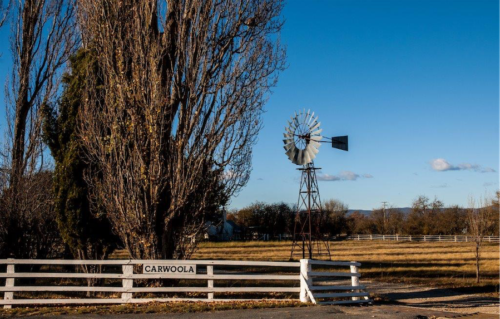
“There’s many a tale told of the tombstones of St Thomas glowing on moonless nights, shadowy figures apparently seen moving in their midst, and even an unknown horseman claimed to silently gallop past its entranceway.” “Yesterdays” columnist NICHOLE OVERALL discovers a spooky church.
ALONG a winding road on Canberra’s outskirts, made lonelier as dusk descends, the Victorian Gothic church sits hidden behind towering pines and hedges, its steeple just visible through the swaying branches.

Adding much to the air of mystique is its graveyard. And on stepping within its consecrated bounds, the ghosts of its long past are palpable – from the stained-glass window, featuring the likeness of a lost local soldier, to at least one parishioner who, after almost a century, remains.
A building “greatly longed for”, it was welcomed on a Sunday 145 years ago. Set between Queanbeyan and Captains Flat, in the “well-grassed, undulating country” of the river plain of the Molonglo, it’s part of one of the oldest and once most impressive landholdings in the region, “Carwoola”.
First known as “Carrowillah”, Aboriginal for “where the water meets the plain”, it was the domain of Irish immigrant Thomas Rutledge. He’d become the squire in the 1840s on purchasing it from his older brother, William, who in 1837 acquired portions from Edward John Eyre before he set off to explore the greater continent. (The brothers would also both later serve briefly as politicians).
The Rutledges came to be landed gentry, Tom greatly expanding his empire to encompass as much as 36,500 hectares all told.
In keeping up with the Joneses – or at least the most influential landholders on the Limestone Plains, the Campbells of Duntroon (1825) – Tom graced his station with an impressive Georgian mansion and a small village for his employees.
Its grazing credentials extended to sheep, cattle and race horses. Just as important was its social function.
Accordingly, along with the land, Tom also provided most of the funds for a church, reminiscent of the Campbell’s house of God, St John’s, blessed in 1845.
The foundation stone of St Thomas was laid two decades later, but another seven years would pass before construction began in 1872.
Much put out by the delay was its designer: son of a Portuguese knight, Parisian-trained engineer, and rector of the Queanbeyan parish, the reverend Alberto Dias Soares.

The clergyman’s sixth such commission – he’d be responsible for some 30 throughout NSW – it was built over two years, using the nearby coppery-tinged stone. With its octagonal tower, belfry, buttresses and carved dripstones keeping the rain from its numerous ornamental windows, it added further grandeur to the essentially solitary surrounds.
Inside, it boasted vaulted timber ceilings, a traditional sanctuary arch and a sandstone baptismal font donated by Soares.
Killed on the Western Front in 1917, Jim Maslin, the 21-year-old son of JF Maslin, “Carwoola’s” owner from 1907, is reflected for eternity in stained glass. There’s also said to have been a World War I honour roll featuring an illustration of “ghostly images of the fallen above the altar whilst a church service is being held”. This seems to have mysteriously disappeared.
And so, to its other purported curiosities.
Well before St Thomas came into being, it’s believed there was already a burial ground, unusual in a number of respects.
Some sources suggest the earliest interment there was the original Molonglo pioneer and former convict, Owen Bowen, in 1840. Despite his prominence, his is an unmarked grave – one of 242 of a similar nature (at least, those known). Ornate headstones, iron fences and plaques for more than 160 others, some damaged over the years in moronic acts of disrespect, are also to be found there.
The church itself though, wasn’t consecrated – that is, “set aside in service of God” – until 1876, suggesting the possibility that the final resting place was unsanctified for more than 30 years. Nonetheless, it was deemed suitable to add a site of worship beside it (rather than the other way around).
Equally outside the norm (according to the Australian Museum’s exhibition, “Death: the last taboo”), the local heritage register notes it’s still possible for people to be buried in the graveyard.
One who lies within is Franc (Bert) Falkiner, “world famous stud sheep breeder” and owner of nearby “Foxlow” from 1920. On his death nine years later, it was recorded in the “Sydney Morning Herald”, that as his cortege passed along the road, in the adjoining field, 13 horses, “as if they had an intuitive knowledge that they were following their master for the last time, formed into a line and for several miles cantered in regular formation alongside the procession”.
Four years on, the ashes of D’arcy Osborne (one of the previous owners of “Foxlow”), “were sealed in a niche under the framework [of a window of memory]”. According to “The Canberra Times”, the “unusual method of remembrance [was] the first of its kind in the district” – and making his place within, everlasting.
There’s also many a tale told by those who’ve long resided in the area of the tombstones of St Thomas glowing on moonless nights, shadowy figures apparently seen moving in their midst, and even an unknown horseman claimed to silently gallop past its entranceway.
Perhaps it’s Thomas, either the man who built this now heritage treasure, or the saint for whom it’s named, continuing to overlook our own Sleepy Hollow.
There’ll be a Thanksgiving Service, 9am, on November 24 followed by a bush band, country fair and tours of the church and cemetery.
For more of its story, anoverallview.wixsite.com/blog
Who can be trusted?
In a world of spin and confusion, there’s never been a more important time to support independent journalism in Canberra.
If you trust our work online and want to enforce the power of independent voices, I invite you to make a small contribution.
Every dollar of support is invested back into our journalism to help keep citynews.com.au strong and free.
Thank you,
Ian Meikle, editor




Leave a Reply